
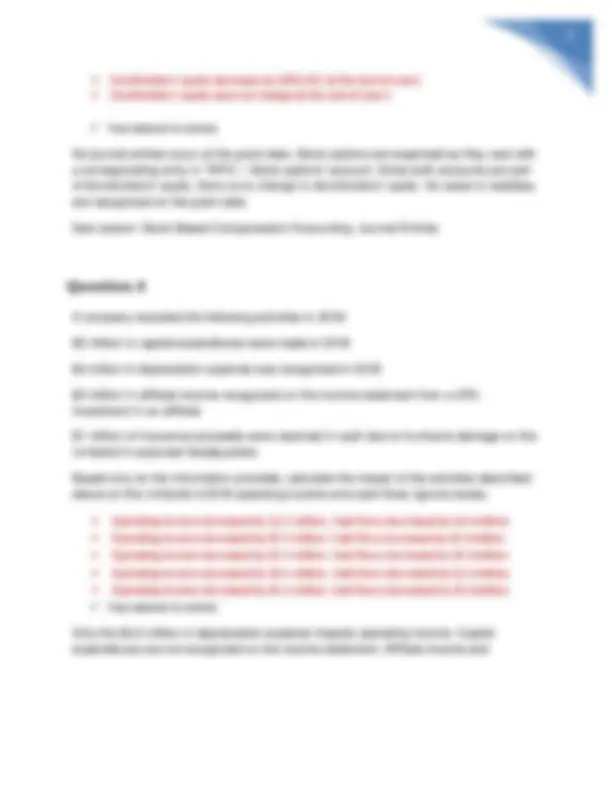
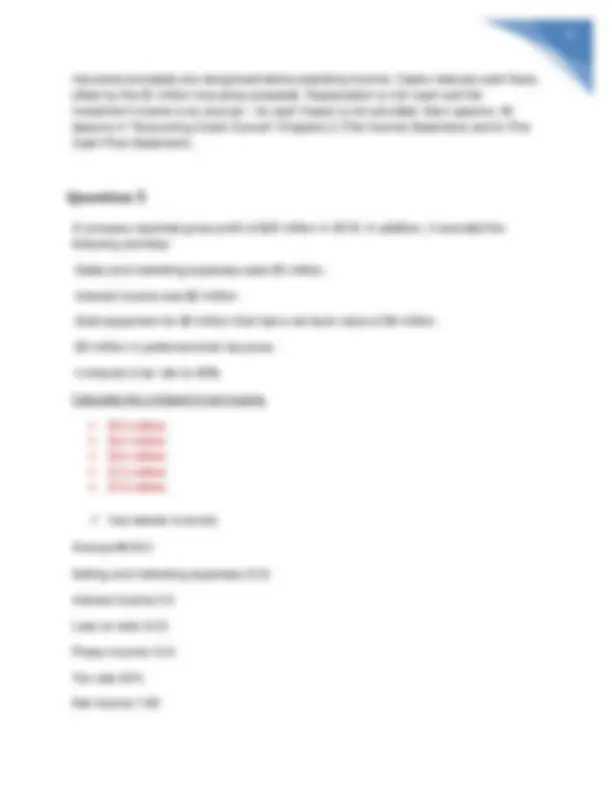
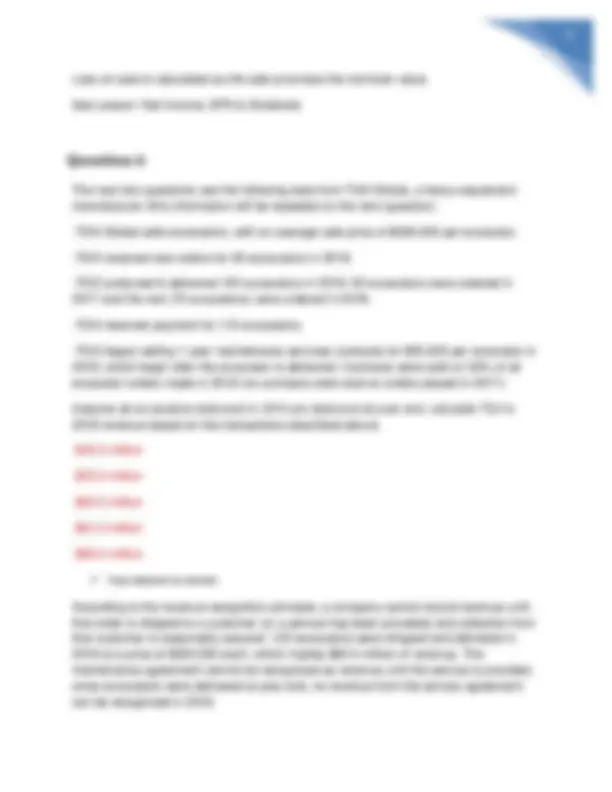
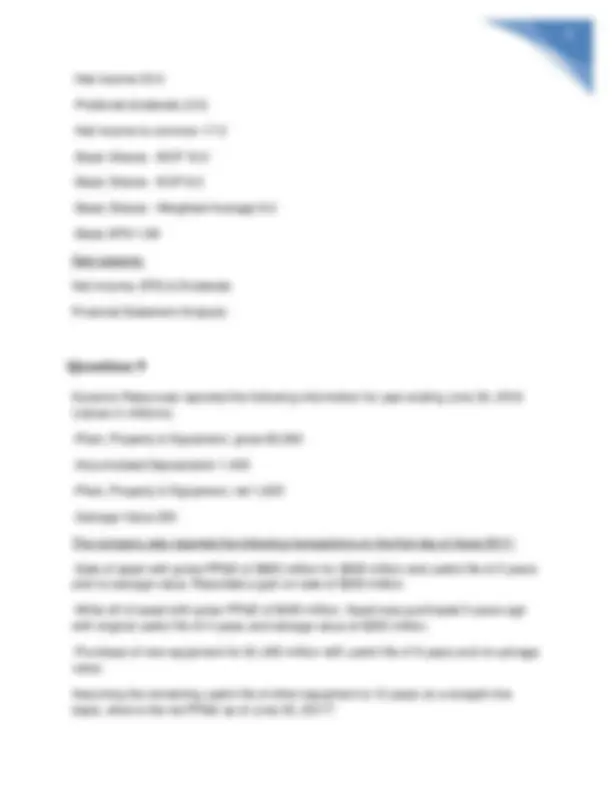
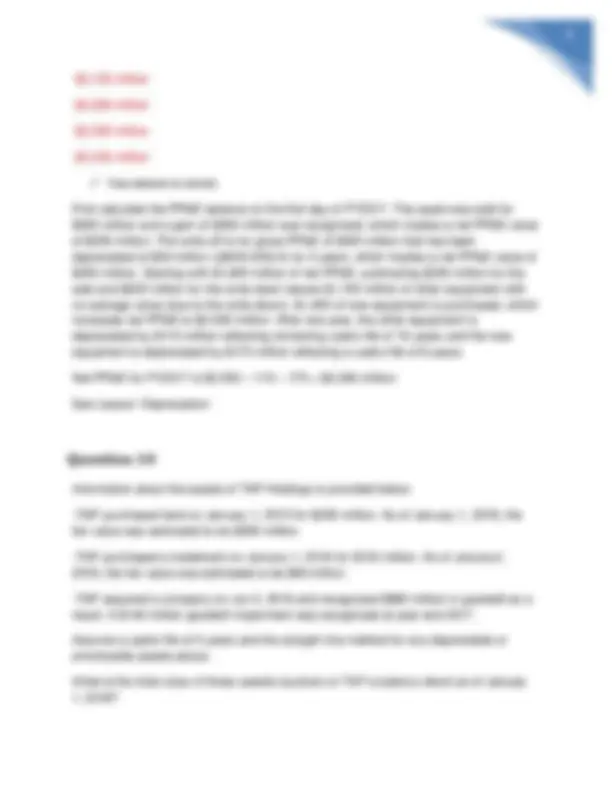

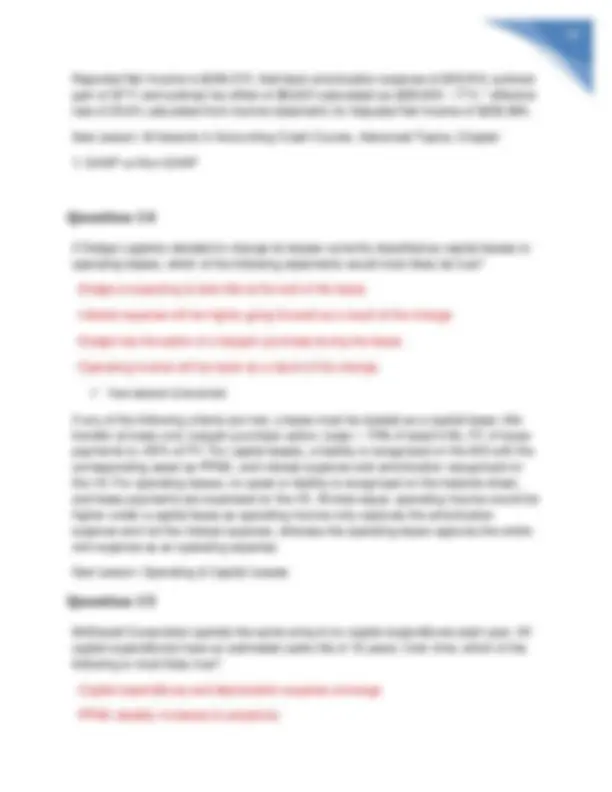
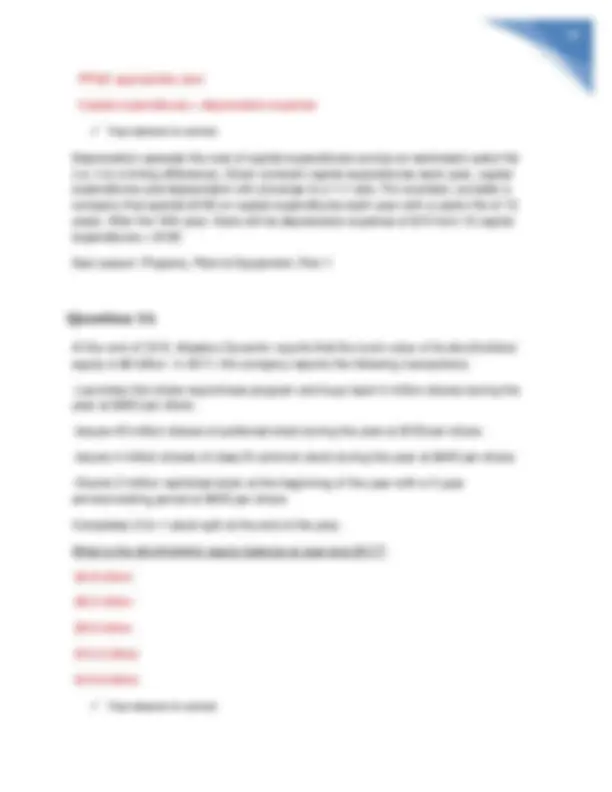
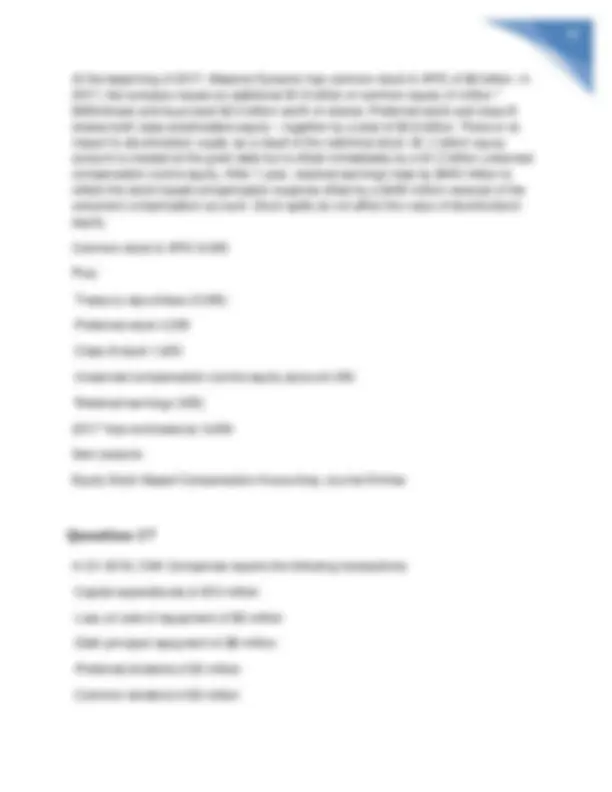
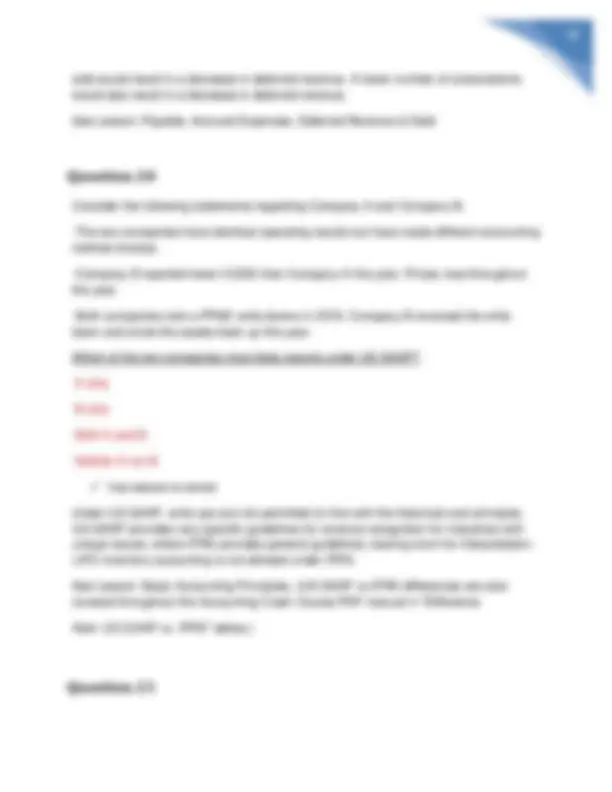
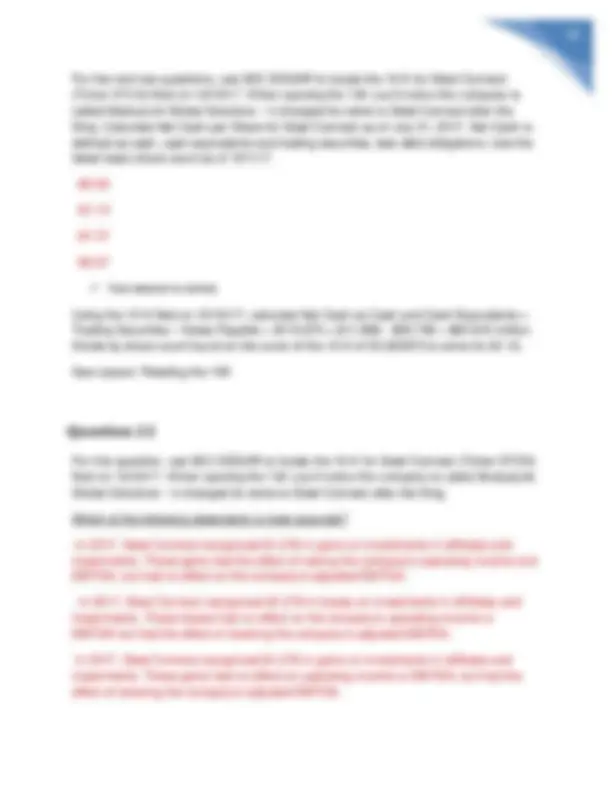
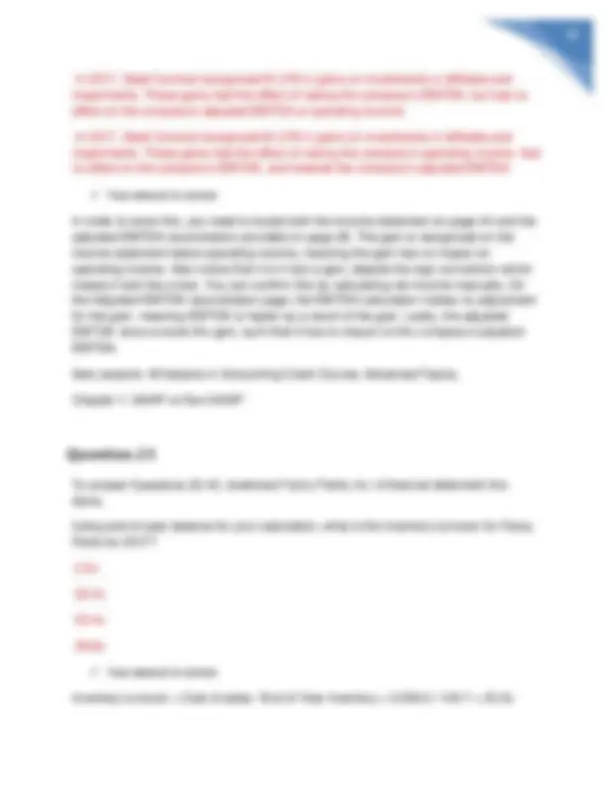
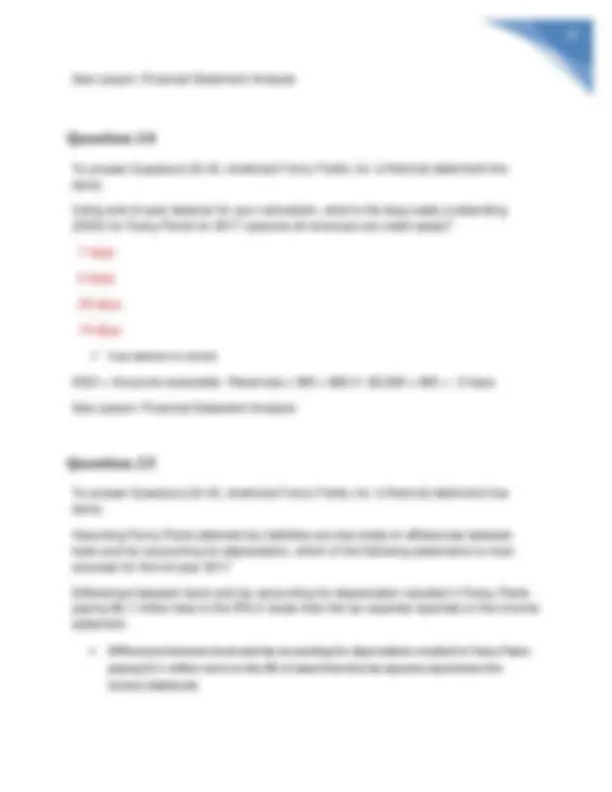

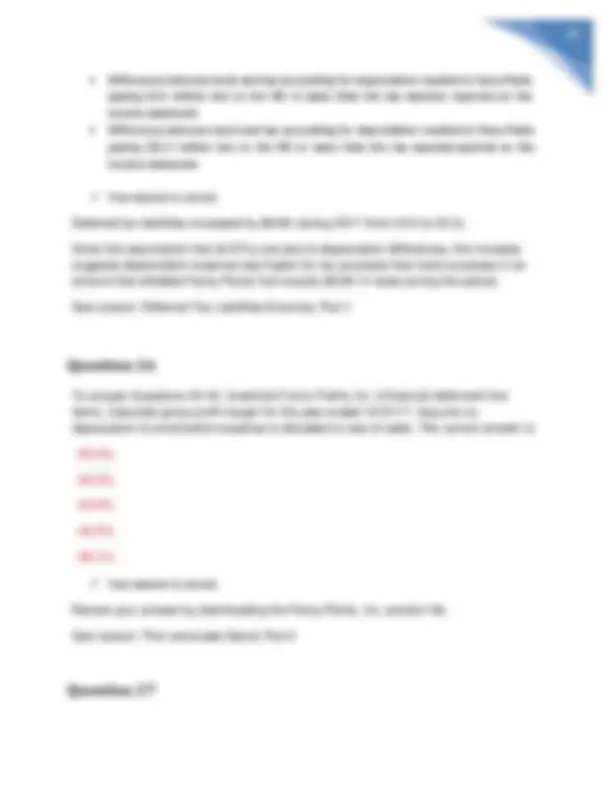

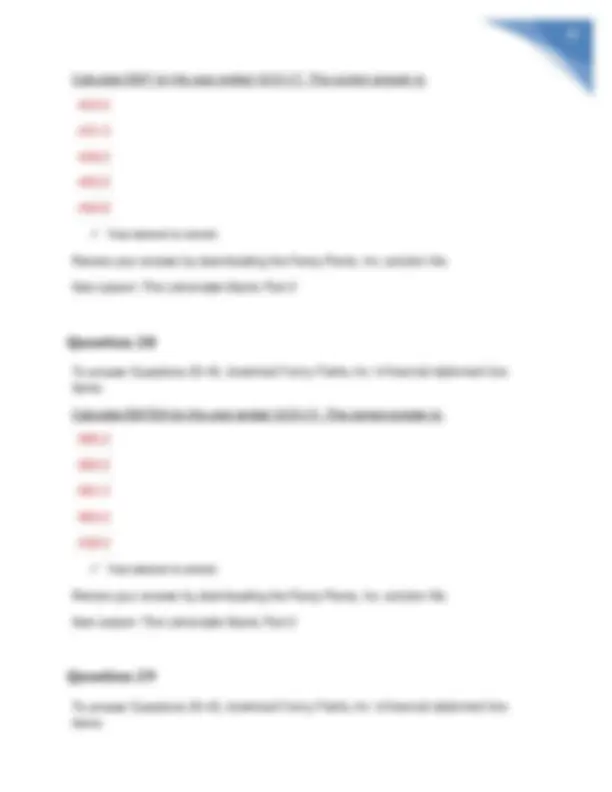
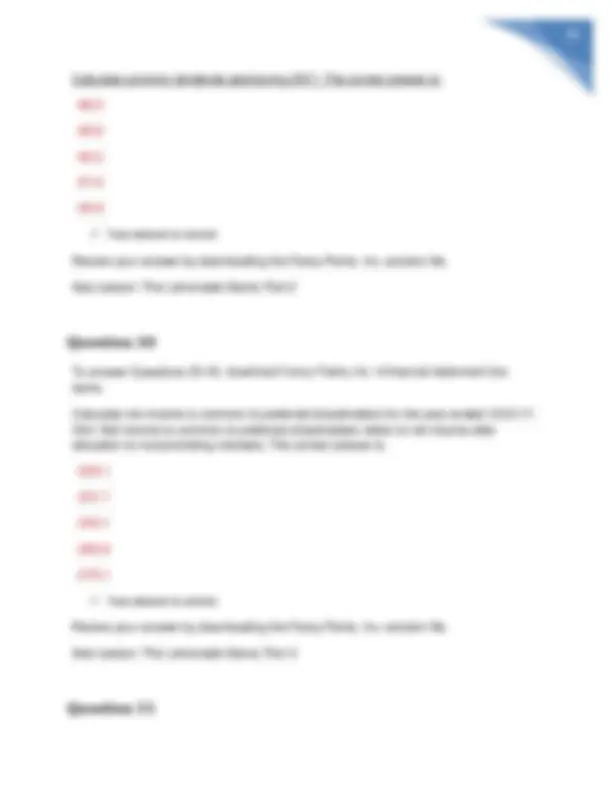
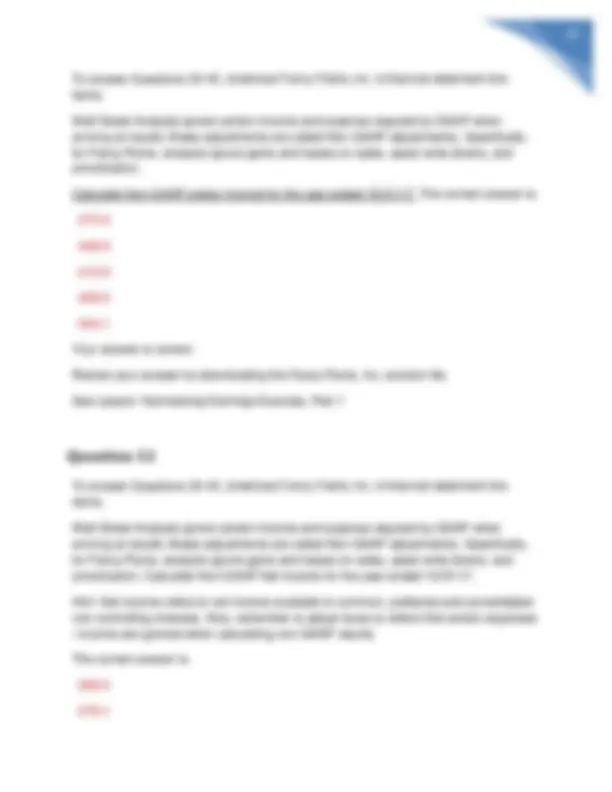
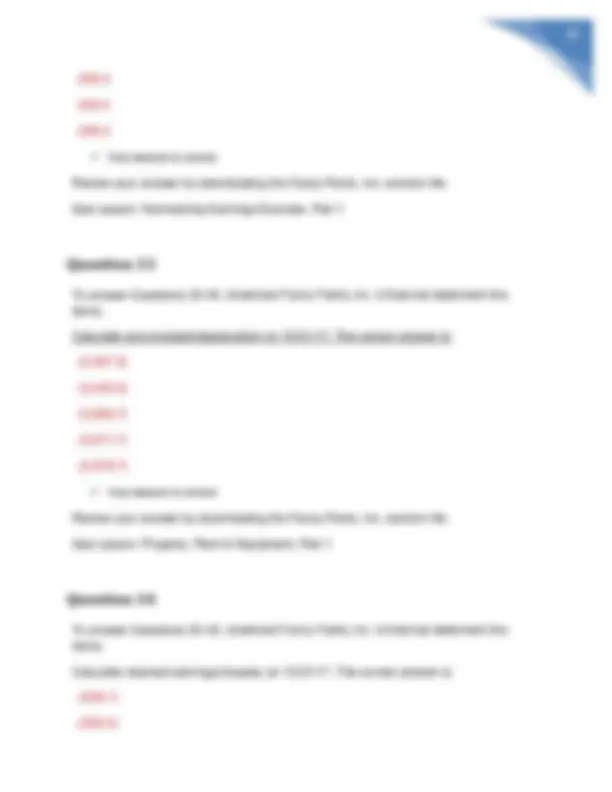
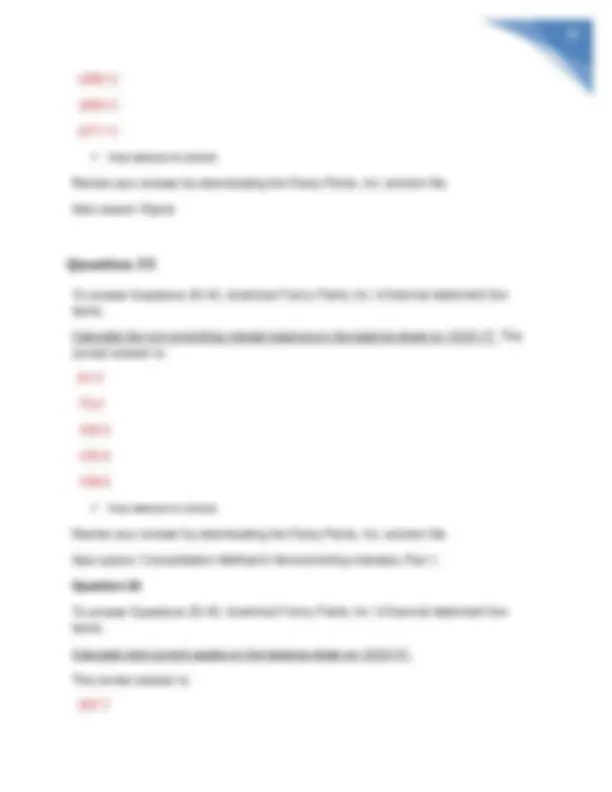
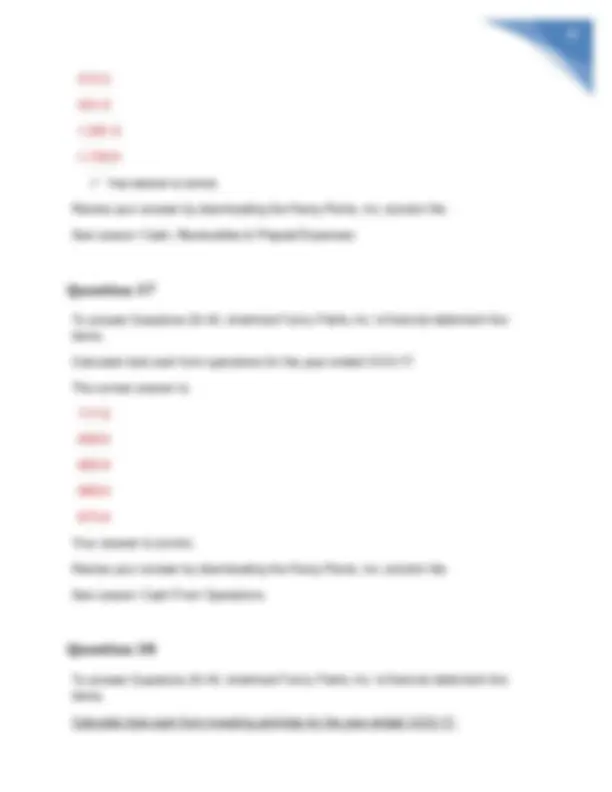
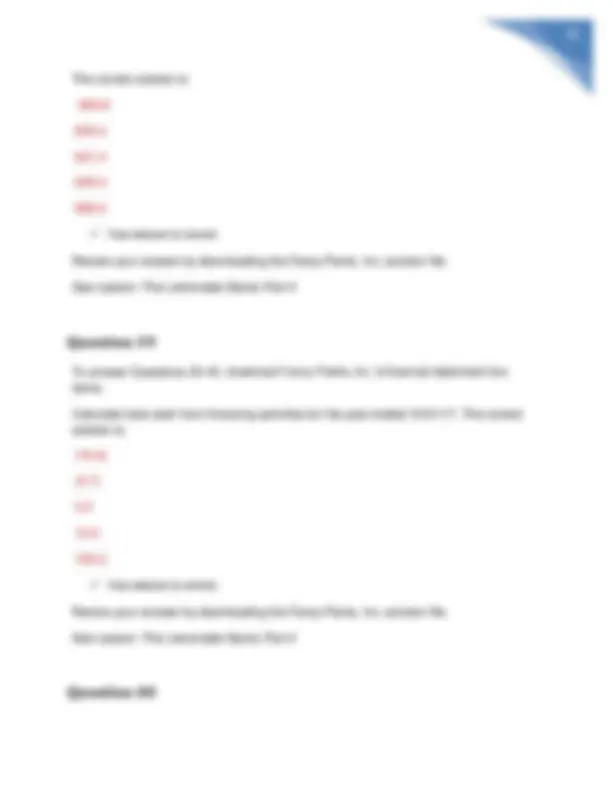
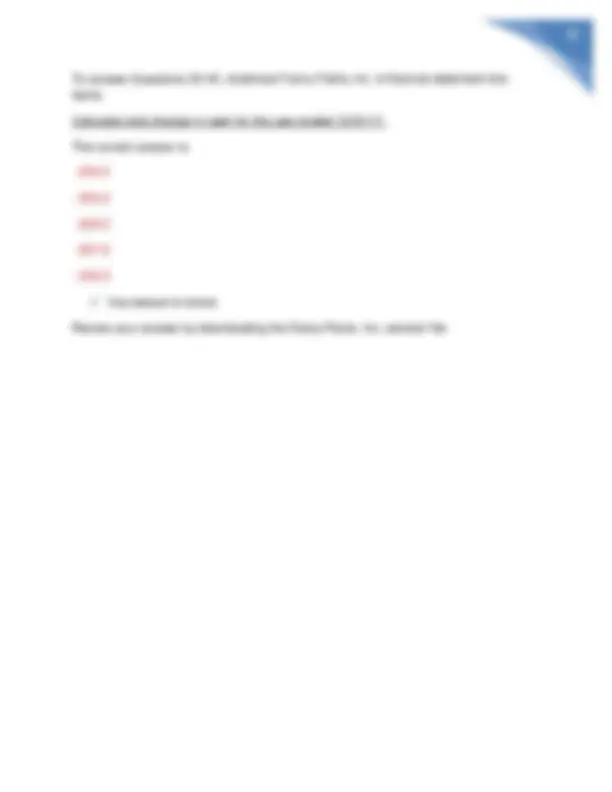


Study with the several resources on Docsity

Earn points by helping other students or get them with a premium plan


Prepare for your exams
Study with the several resources on Docsity

Earn points to download
Earn points by helping other students or get them with a premium plan
Community
Ask the community for help and clear up your study doubts
Discover the best universities in your country according to Docsity users
Free resources
Download our free guides on studying techniques, anxiety management strategies, and thesis advice from Docsity tutors
Wall Street Prep The Premium Package Review: Accounting & Financial Statement Analysis Exam./Wall Street Prep The Premium Package Review: Accounting & Financial Statement Analysis Exam./Wall Street Prep The Premium Package Review: Accounting & Financial Statement Analysis Exam.
Typology: Exams
1 / 32

This page cannot be seen from the preview
Don't miss anything!

























Score: 95%, 38 correct out of 40
Assume US GAAP to answer this question.
In 2017, $2 million in wages were earned and no cash wages were paid. In 2018, $ million in wages were earned and $7 million in cash wages were paid. Cash wages were used to first pay wages earned in 2017 with the remainder used to pay wages earned in 2018. Any earned but unpaid wages will be paid during the first quarter of
Liabilities increased by $1.0 million in 2018 Liabilities increased by $3.0 million in 2018 Assets decreased by $5.0 million in 2018 Retained earnings decreased by $10.0 million in 2018 Retained earnings decreased by $7.0 million in 2018
Your answer is correct.
Since wages were earned in 2017 but not yet paid, the opening balance sheet in 2018 would have an accrued wages liability of $2.0. These were paid in 2018, reversing the liability. However, since there is only $5.0 million in cash ($7.0 less the $2.0 million used to pay 2017 wages) available to pay wages earned in 2018, that leaves $3.0 million in earned wages unpaid, raising the accrued wages liability to $3.0 million. The net impact to the liability is $1.0 million (-$2.0 + $3 million). The only asset impacted is cash, which decreases by $7.0 million, while retained earnings decreases by $8.0 million, since wages are expensed when they are earned, not when they are paid.
See Lesson: Payable, Accrued Expenses, Deferred Revenue & Debt
A company issued its CEO 100,000 shares of restricted stock in the beginning of 2018 that are restricted for two years. The current share price is $10. Based on the information provided, which of the following statements is true?
An unearned compensation liability in the amount of $1 million is created at thegrant date An unearned compensation asset in the amount of $1 million is created at thegrant date Stockholders' equity increases by $1 million at the grant date An unearned compensation contra equity account in the amount of $500,000 is recognized at the grant date
Stockholders' equity is unchanged at the grant date
Your answer is correct.
The entire value of restricted stock issued at grant date is recognized as an equity account and is immediately offset by a contra equity account in the same amount so there is no change to stockholders’ equity at the grant date. This contra equity account is reversed over the service period. In this case, a $1 million contra equity account is created and reduced by $500,000 over the next two years, with an offsetting reduction in retained earnings.
See Lesson: Stock Based Compensation Accounting: Journal Entries
A company issued its CEO 100,000 stock options in the beginning of 2018 that will vest equally over 2 years. Assume the following:
The share price at grant date is $10 per share
The option exercise price is $10 per share
The fair value of each option at grant date is $5 per share
No options are exercised until after year 2
Based only on the information provided, which of the following statements is true?
Stockholders' equity increases by $1,000,000 at the grant date Stockholders' equity increases by $500,000 at the grant date Stockholders' equity increases by $250,000 at the grant date
insurance proceeds are recognized below operating income. Capex reduces cash flows, offset by the $1 million insurance proceeds. Depreciation is non-cash and the investment income is an accrual – its cash impact is not provided. See Lessons: All lessons in "Accounting Crash Course" Chapters 2 (The Income Statement) and 6 (The Cash Flow Statement).
A company reported gross profit of $20 million in 2018. In addition, it recorded the following activities:
-Sales and marketing expenses were $5 million.
-Interest income was $2 million.
-Sold equipment for $5 million that had a net book value of $9 million.
-$3 million in preferred stock issuance.
Calculate the company’s net income.
$5.4 million $6.0 million $6.8 million $7.2 million $7.8 million
Your answer is correct.
Gross profit 20.
Selling and marketing expenses (5.0)
Interest income 2.
Loss on sale (4.0)
Pretax income 13.
Tax rate 40%
Net income 7.
Loss on sale is calculated as the sale price less the net book value.
See Lesson: Net Income, EPS & Dividends
The next two questions use the following data from TGX Global, a heavy equipment manufacturer (this information will be repeated on the next question):
-TGX Global sells excavators, with an average sale price of $500,000 per excavator.
-TGX received new orders for 90 excavators in 2018.
-TGX produced & delivered 120 excavators in 2018: 50 excavators were ordered in 2017 and the rest (70 excavators) were ordered in 2018.
-TGX received payment for 110 excavators.
-TGX began selling 1-year maintenance services contracts for $50,000 per excavator in 2018, which begin after the excavator is delivered. Contracts were sold on 50% of all excavator orders made in 2018 (no contracts were sold on orders placed in 2017).
Assume all excavators delivered in 2018 are delivered at year end, calculate TGX’s 2018 revenue based on the transactions described above.
$45.0 million
$55.0 million
$60.0 million
$61.0 million
$66.0 million
Your answer is correct.
According to the revenue recognition principle, a company cannot record revenue until that order is shipped to a customer (or a service has been provided) and collection from that customer is reasonably assured. 120 excavators were shipped and delivered in 2018 at a price of $500,000 each, which implies $60.0 million of revenue. The maintenance agreement cannot be recognized as revenue until the service is provided, since excavators were delivered at year end, no revenue from the service agreement can be recognized in 2018.
Your answer is correct.
Gross profit is revenue less cost of goods sold. Cost of Goods sold represents a company's direct cost to manufacture or procure goods and services. According to the matching principle, costs associated with the production of the book should be recorded in (matched to) the same period as the revenue from the book’s sale. Revenue from 100 excavators was recognized and the corresponding cost of $300,000 each or $ million should be matched. In addition, shipping, delivery and direct labor costs are included in the direct production of the excavator and should thus be included in COGS. Sales, marketing and general expenses are not included in COGS.
See Lesson: COGS & Gross Profit
Fairview Corporation recorded the following in 2018:
-After-tax net income was $20 million in 2018.
-The actual share count at the beginning of the year was 10.0 million.
-Fairview repurchased 2 million shares at $12/share in the middle of 2018.
-Fairview issued preferred dividends of $3 million and common dividends of $2 million.
-Fairview issued 4 million stock options in 2018 that begin to vest in 2019.
Calculate 2018 basic earnings per share (EPS).
Your answer is correct.
Net income must be reduced by preferred dividends in the basic EPS calculation. Unvested shares do not get included in the basic share count, only the diluted. The share count is a weighted average. Since shares were repurchased midyear, the average is 10x50% + 8x50% = 9.0 weighted average shares.
-Net income 20.
-Preferred dividends (3.0)
-Net income to common 17.
-Basic Shares - BOP 10.
-Basic Shares - EOP 8.
-Basic Shares - Weighted Average 9.
-Basic EPS 1.
See Lessons:
Net Income, EPS & Dividends
Financial Statement Analysis
Dynamic Resources reported the following information for year ending June 30, 2016 (values in millions):
-Plant, Property & Equipment, gross $3,
-Accumulated Depreciation 1,
-Plant, Property & Equipment, net 1,
-Salvage Value 200
The company also reported the following transactions on the first day of fiscal 2017:
-Sale of asset with gross PP&E of $600 million for $500 million and useful life of 3 years and no salvage value. Recorded a gain on sale of $300 million.
-Write off of asset with gross PP&E of $400 million. Asset was purchased 3 years ago with original useful life of 4 years and salvage value of $200 million.
-Purchase of new equipment for $1,400 million with useful life of 8 years and no salvage value.
Assuming the remaining useful life of other equipment is 10 years on a straight-line basis, what is the net PP&E as of June 30, 2017?
$1,070 million
$890 million
$1,170 million
$1,140 million
Your answer is correct.
GAAP financial statements report companies’ resources at an initial historical cost (unless written down). GAAP requires that firms only show measurable activities, such as the value of acquired intangible assets. The current reported value of the land would be the lower historical cost of $250. The current reported value of the trademark would be written down to the lower fair value of $80. Goodwill would also be reported at the lower fair value of $740. The total value of the assets would be $250 + $80 + $740 = $1,070. Land, trademarks and goodwill are considered are generally considered to have indefinite useful lives and not depreciated or amortized.
See Lessons:
Basic Accounting Principles
Intangible Assets & Goodwill
For the next 3 questions, use the financials of Acme Corporation.
Based solely on the information provided in the financials, how much cash did Acme generate from revenue for the nine months ending September 30, 2017?
$851.7 million
$892.1 million
$939.4 million
$979.8 million
Your answer is correct.
Accounts receivable increased by $87.7 million, implying that the company not collect that amount in cash. Deferred revenue increased by $40.4 million, which the company
collected but did not book as sales. Therefore, cash collection was $939.4 million – $87.7 million + $40.4 million = $892.1 million.
See Lessons:
Cash, Receivables & Prepaid Expenses
Payable, Accrued Expenses, Deferred Revenue & Debt
For the next 2 questions, use the financials of Acme Corporation.
Note the industry average ratios below:
-A/R days (based on average balances) = 57 days
-A/P days (based on average balances) = 23 days
-Current ratio (based on ending balance) = 1.8x
Based on Acme’s A/R days, A/P days and Current ratios for the nine months ending September 30, 2017, which of the following conclusions is most accurate? Assume 273 days in the nine months ending September 30, 2017 and 365 days in the year.
Compared to the industry average:
-Acme has more favorable collection terms but less favorable payment terms with vendors.
-Acme has more favorable collection terms and more favorable payment terms with vendors.
-Acme has less favorable collection terms and less favorable payment terms with vendors.
-Acme has less favorable payment terms with vendors and a less favorable current ratio.
-Acme has less favorable collection terms and less favorable current ratio.
Your answer is incorrect.
The activity ratios are calculated below:
Activity ratios Acme Industry
Reported Net Income is $239,370. Add back amortization expense of $29,919, subtract gain of $771 and subtract tax effect of $8,623 (calculated as ($29,929 – 771) * effective rate of 29.6% calculated from income statement) for Adjusted Net Income of $259,895.
See Lesson: All lessons in Accounting Crash Course, Advanced Topics, Chapter
1: GAAP vs Non-GAAP
If Dodge Logistics decided to change its leases currently classified as capital leases to operating leases, which of the following statements would most likely be true?
-Dodge is expecting to take title at the end of the lease.
-Interest expense will be higher going forward as a result of the change.
-Dodge has the option of a bargain purchase during the lease.
-Operating income will be lower as a result of the change.
Your answer is incorrect.
If any of the following criteria are met, a lease must be treated as a capital lease: title transfer at lease end, bargain purchase option, lease > 75% of asset’s life, PV of lease payments is >90% of FV. For capital leases, a liability is recognized on the B/S with the corresponding asset as PP&E, and interest expense and amortization recognized on the I/S. For operating leases, no asset or liability is recognized on the balance sheet, and lease payments are expensed on the I/S. All else equal, operating income would be higher under a capital lease as operating income only captures the amortization expense and not the interest expense, whereas the operating lease captures the entire rent expense as an operating expense.
See Lesson: Operating & Capital Leases
McDowell Corporation spends the same amount on capital expenditures each year. All capital expenditures have an estimated useful life of 10 years. Over time, which of the following is most likely true?
-Capital expenditures and depreciation expense converge
-PP&E steadily increases to perpetuity
-PP&E approaches zero
-Capital expenditures > depreciation expense
Your answer is correct.
Depreciation spreads the cost of capital expenditures across an estimated useful life (i.e. it is a timing difference). Given constant capital expenditures each year, capital expenditures and depreciation will converge to a 1:1 ratio. For example, consider a company that spends $100 on capital expenditures each year with a useful life of 10 years. After the 10th year, there will be depreciation expense of $10 from 10 capital expenditures = $100.
See Lesson: Property, Plant & Equipment, Part 1
At the end of 2016, Massive Dynamic reports that the book value of its stockholders’ equity is $6 billion. In 2017, the company reports the following transactions:
-Launches first share repurchase program and buys back 5 million shares during the year at $400 per share.
-Issues 40 million shares of preferred stock during the year at $100 per share.
-Issues 4 million shares of class B common stock during the year at $400 per share.
-Grants 3 million restricted stock at the beginning of the year with a 3-year service/vesting period at $400 per share.
Completes 2 for 1 stock split at the end of the year.
What is the stockholders’ equity balance at year-end 2017?
$4.8 billion
$9.2 billion
$9.6 billion
$10.0 billion
$10.8 billion
Your answer is correct.
-Share buyback of $4 million
What is the impact of these transactions on retained earnings?
($9 million)
($11 million)
($16 million)
($38 million)
Your answer is correct.
Retained earnings represent a company’s cumulative earnings, net of dividends, over its entire existence and is not impacted by financing activities such as debt issuance/paydown or stock issuance/buybacks. Capital expenditures do not directly impact retained earnings. Rather, the resulting depreciation expense, which is not reported, has an impact. The total impact is ($11 million), comprised of ($6 million) from the loss on sale and ($5 million) from preferred and common dividends.
See Lessons:
Equity Method, Part 2
OID Zero Coupon Exercise
In 2017, ABC Chemicals reports the following items:
$20,000 loss related to a PP&E impairment
$6,000 net income attributable to non-controlling interests
$25,000 loss on foreign currency translation
$5,000 gain related to patent infringement award
What is the impact of the above items on retained earnings in 2017 (assume no taxes)?
$9,000 decrease
$21,000 decrease
$34,000 decrease
$46,000 decrease
Your answer is correct.
All items above impact retained earnings except for the foreign currency translation loss which impacts other comprehensive income. Net income to non controlling interests is a reduction to retained earnings.
See Lessons:
Equity
Consolidation Method & Noncontrolling Interests, Part 1
Blueberry is a consumer technology company that reported the following financials (values in millions):
2017 2018
Revenue $851 $
Deferred Revenue (ending balance) $347 $
Which of the following statements about the reason for the increase in deferred revenue from 2017 to 2018 is most plausible?
-More revenue was recognized than cash was collected during 2018.
-More gift cards have been redeemed than sold during 2018.
-Lower number of prepaid streaming service subscriptions were sold during 2018.
-A higher number of smartphone extended warranty contracts were sold during 2018.
Your answer is correct.
Deferred revenue represents sales that a company has received payment for but not yet earned and therefore cannot classify as revenues on the income statement. A higher number of extended warranty contracts would result in higher deferred revenue as cash is collected upfront with a corresponding deferred revenue liability, which is reversed in the future as revenue is recognized over the life of the warranty contracts. Other examples of unearned revenues are magazine subscription (a company has not yet delivered those magazines to customers) and gift cards. More gift cardsredeemed than
For the next two questions, use SEC EDGAR to locate the 10-K for Steel Connect (Ticker STCN) filed on 10/16/17. When opening the 10K you’ll notice the company is called ModusLink Global Solutions – it changed its name to Steel Connect after the filing. Calculate Net Cash per Share for Steel Connect as of July 31, 2017. Net Cash is defined as cash, cash equivalents and trading securities, less debt obligations. Use the latest basic share count as of 10/1/17.
-$0.
-$1.
-$1.
-$2.
Your answer is correct.
Using the 10-K filed on 10/16/17, calculate Net Cash as Cash and Cash Equivalents + Trading Securities – Notes Payable = $110.670 + $11.898 - $59.758 = $62.810 million. Divide by share count found on the cover of the 10-K of 55.555973 to solve for $1.13.
See Lesson: Reading the 10K
For this question, use SEC EDGAR to locate the 10-K for Steel Connect (Ticker STCN) filed on 10/16/17. When opening the 10K you’ll notice the company is called ModusLink Global Solutions – it changed its name to Steel Connect after the filing.
Which of the following statements is most accurate?
-In 2017, Steel Connect recognized $1,278 in gains on investments in affiliates and impairments. These gains had the effect of raising the company's operating income and EBITDA, but had no effect on the company's adjusted EBITDA.
-In 2017, Steel Connect recognized $1,278 in losses on investments in affiliates and impairments. These losses had no effect on the company's operating income or EBITDA but had the effect of lowering the company's adjusted EBITDA.
-In 2017, Steel Connect recognized $1,278 in gains on investments in affiliates and impairments. These gains had no effect on operating income or EBITDA, but had the effect of lowering the company's adjusted EBITDA.
-In 2017, Steel Connect recognized $1,278 in gains on investments in affiliates and impairments. These gains had the effect of raising the company's EBITDA, but had no effect on the company's adjusted EBITDA or operating income.
-In 2017, Steel Connect recognized $1,278 in gains on investments in affiliates and impairments. These gains had the effect of raising the company's operating income, had no effect on the company's EBITDA, and lowered the company's adjusted EBITDA.
Your answer is correct.
In order to solve this, you need to locate both the income statement on page 44 and the adjusted EBITDA reconciliation provided on page 26. The gain is recognized on the income statement below operating income, meaning the gain has no impact on operating income. Also notice that it is in fact a gain, despite the sign convention which makes it look like a loss. You can confirm this by calculating net income manually. On the Adjusted EBITDA reconciliation page, the EBITDA calculation makes no adjustment for the gain, meaning EBITDA is higher as a result of the gain. Lastly, the adjusted EBITDA does exclude the gain, such that it has no impact on the company’s adjusted EBITDA.
See Lessons: All lessons in Accounting Crash Course, Advanced Topics,
Chapter 1: GAAP vs Non-GAAP
To answer Questions 23-40, download Fancy Pants, Inc.’s financial statement line items.
Using end-of-year balance for your calculation, what is the inventory turnover for Fancy Pants for 2017?
2.5x
22.3x
23.4x
39.8x
Your answer is correct.
Inventory turnover = Cost of sales / End of Year Inventory = 3,256.0 / 145.7 = 22.3x